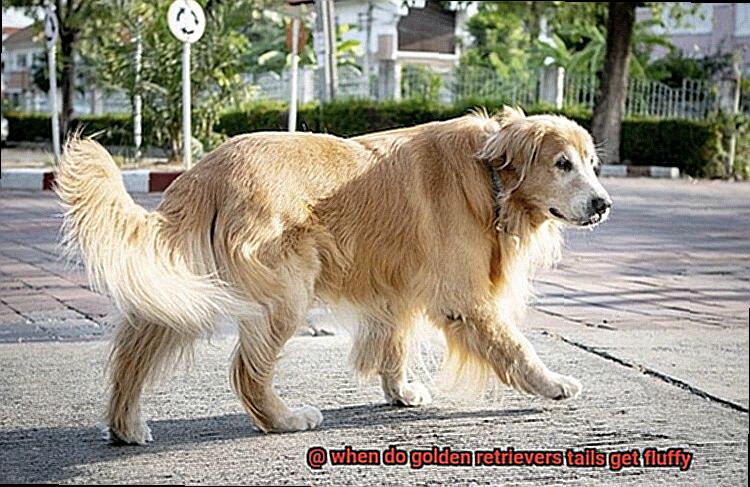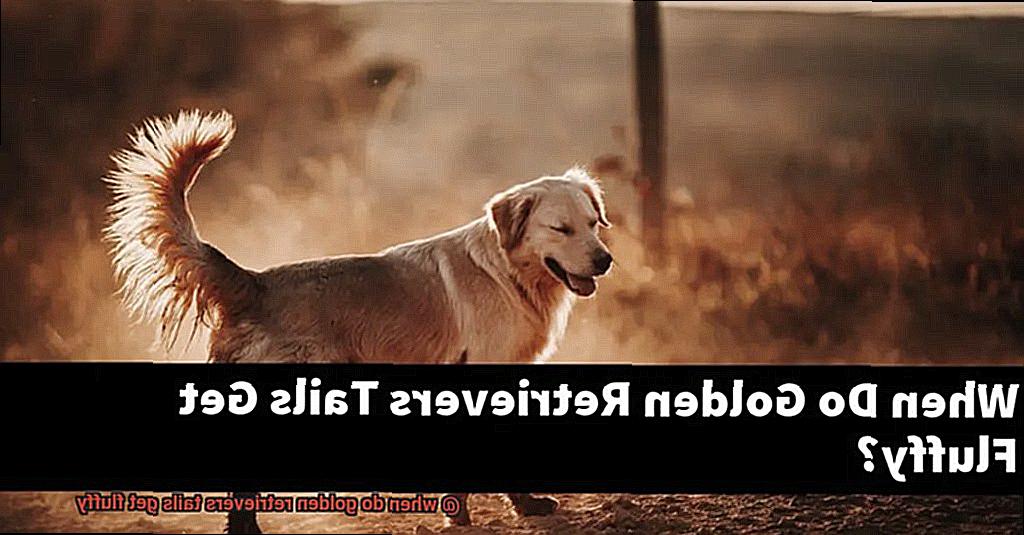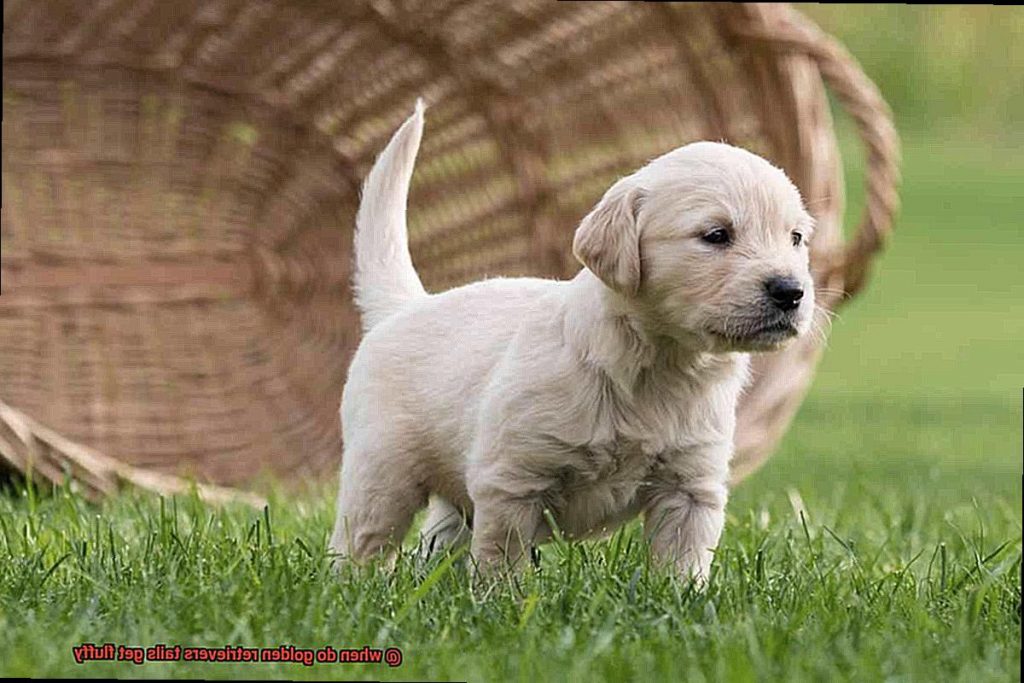Golden retrievers are undoubtedly one of the most beloved dog breeds in the world. Their playful personalities, boundless energy, and undying loyalty make them the perfect family pet. But what really sets these dogs apart from others is their fluffy, feathery tails. Have you ever wondered when golden retrievers’ tails get fluffy?
Believe it or not, most golden retriever pups are born with tails that are already pretty fluffy. However, as they age and reach full maturity at around 1-2 years old, their tail fluffiness tends to increase even more. This is due to their coats thickening and becoming more luxurious over time, with the telltale plume of fur on their tails growing bigger and more impressive by the day.
But why do golden retrievers have such fluffy tails in the first place? While there’s no definitive answer to this question, experts believe that genetics and practicality play a role in it. The fur on their tails helps protect them from harsh weather conditions or thorny bushes while also communicating friendly intent or aggression to other dogs.
If you’re a proud golden retriever owner or just an avid dog lover curious about these furry friends’ tails, then this blog post is for you. We’ll dive deeper into the fascinating world of golden retriever tails and share some fun facts about these lovable dogs. So gear up to learn everything there is to know about this adorable canine feature – from when and why their tails get fluffy to how you can keep them looking their best.
The Development of a Golden Retriever’s Coat
Contents
Golden Retrievers are a beloved dog breed, known for their friendly, loyal personalities and their adorable appearance, especially their long, fluffy tails. However, have you ever wondered when a Golden Retriever’s tail becomes fluffy? To answer this question, we need to explore the development of their coat.
From birth to six months of age, Golden Retrievers have a soft and fluffy puppy coat that is not fully developed yet. During this time, their coat is delicate and requires extra care. At around six months of age, Golden Retrievers enter a transitional phase where their puppy coat is replaced by an adult coat. This phase can take up to a year to complete.
Around one year of age is when a Golden Retriever’s coat has fully developed into its adult form. Their coat will be thicker and wavier than the puppy coat, with longer fur around the neck, legs, and tail. This is when a Golden Retriever’s tail is at its fluffiest and most beautiful stage, making them even more irresistible than before.
While genetics play a significant role in a Golden Retriever’s coat development, other factors such as diet and grooming habits can also impact the quality and fluffiness of their tail. A healthy diet rich in essential nutrients can promote hair growth and prevent shedding while ensuring proper grooming can help distribute natural oils and keep their coat shiny and tangle-free.
When do Golden Retrievers Tails Get Fluffy?

Golden Retriever puppies are born with tails that aren’t very fluffy. However, as they grow older, their tails start to become more bushy and fluffy, usually between the ages of 3-6 months. During this time, it’s crucial to establish a healthy grooming routine for your furry friend to ensure they maintain a healthy coat and tail.
Proper diet also plays an essential role in your Golden Retriever’s tail fluffiness. Feeding your dog a balanced diet rich in protein, vitamins, and minerals promotes healthy hair growth and prevents shedding. Nutritious food can prevent dryness and brittleness of the hair, making it easier for the tail to become fluffy.
Genetics also play a part in determining the fluffiness of a Golden Retriever’s tail. Some dogs may have naturally fluffier tails than others due to their genetic makeup. However, proper grooming and nutrition can help enhance its appearance.
Remember that each dog is unique and may have different fluffiness levels in their tails. But by providing your Golden Retriever with proper nutrition and grooming care from an early age, you can help ensure they have a healthy and fluffy tail throughout their life.
Genetics and Fluffiness of the Tail

It’s no secret that genetics play a pivotal role in determining the fluffiness of these dogs’ tails. The breed standard mandates a dense, water-repellent coat that covers the entire body, including the tail. This long appendage should be draped in wavy fur that forms a delicate fringe. These traits are passed down from a dog’s parents, which means if both parents have fluffy tails, their offspring are likely to follow suit. However, if one parent has a fluffy tail and the other has a smoother one, their offspring may exhibit varying degrees of fluffiness.
Nonetheless, genetics aren’t the only factor at play when it comes to tail fluffiness. Regular grooming is crucial for preserving those poofy tails. Mats and tangles can wreak havoc on these delicate strands, so brushing and combing your dog’s coat regularly is essential.
Moreover, nutrition and overall health can also impact a Golden Retriever’s coat quality. A wholesome diet loaded with essential fatty acids can promote healthy skin and hair growth.
Grooming and Nutrition to Maintain a Healthy Coat
You know that maintaining a healthy and shiny coat requires more than just good genetics. The secret to a luscious tail lies in proper grooming and nutrition.
First things first, let’s talk about grooming. Regular brushing is essential to prevent matting and remove dead hair. Brushing their fur at least twice a week distributes the natural oils in their skin, which keeps their coat moisturized and reduces shedding. But be careful not to overdo it – excessive grooming or bathing can actually damage their coat, stripping away natural oils and causing dryness and irritation. Aim to bathe them no more than once every 6-8 weeks, using a gentle dog shampoo that is formulated for their sensitive skin.
Now, let’s shift our focus to nutrition. A balanced diet that contains protein, vitamins, minerals, and essential fatty acids is crucial for maintaining a healthy coat on a Golden Retriever. Without the right nutrients, their coat may become dull, brittle, or even fall out. So, it’s important to choose high-quality dog food that contains these essential nutrients to keep your Golden Retriever’s skin and fur healthy.
Consult with your vet to determine the best diet plan for your furry friend. Remember that proper nutrition is just as important as regular grooming when it comes to maintaining a healthy and shiny coat.
Conclusion
To wrap things up, it’s safe to say that Golden Retrievers are a breed that has captured the hearts of many. Their charming personalities and fluffy tails are just some of the reasons why they have become such a popular choice for pet owners around the world.
As we’ve discovered, these lovable pups are born with some fluffiness on their tails, but as they mature, their tail fluffiness tends to increase even more. While genetics play a significant role in determining the quality of their coat, there are other factors at play as well.
For example, regular grooming is essential for maintaining those poofy tails while ensuring that your furry friend stays healthy and happy. Additionally, feeding them a diet rich in essential fatty acids can promote healthy skin and hair growth.
By taking proper care of your Golden Retriever from an early age, you can help them maintain a beautiful coat throughout their life.









